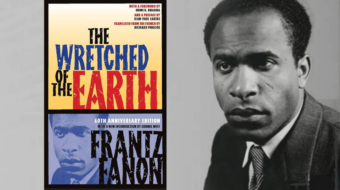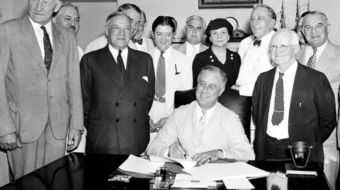
In 2011, a unique program called “The Soviet Arts Experience” took up temporary residence in concert halls, art galleries, and theater stages around the greater Chicago area. One of the byproducts and lasting artifacts of this enterprise is the book “Vision and Communism.”
Soviet posters featuring avant-garde photo-montage images produced by Bolshevik artists still flushed with revolutionary victory are rather well documented. Even today, images from such designs are frequently reproduced in slightly less proletarian backdrops such as in television commercials for the Turner Classic Movies cable television station.
This experimentation of pushing the boundaries of the medium of poster art did not end in the 1930s however. The Soviets continued to use the poster as a medium of mass communication both to extol the virtues of socialism to their own population and to inspire those beyond their borders, often to dazzling effect, right up until 1991.
Soviet artist Viktor Kortesky said, “The poster always works on the leading edge, in the thick of events, and precisely for this reason its representational form must be developed and kept new.” “Vision and Communism” focuses on his prolific and provocative career as a purveyor of proletarian ideas via the poster.
Koretsky’s work is not just a collection of memorable images and strident slogans meant to awaken and inform. Some of his work rises to the level of high art. Such is the case with the poster entitled “Capitalism is War, The Peoples Suffering, And Tears.” This poster was in fact presented in its original maquette form at an installation at Chicago’s Smart Museum that ran until January 2012. Its stark beauty summaries the agony felt by those ground up and cast aside by a system characterized by exploitation, fear, and suffering.
The book traces in detail the unique history, design, and usage of posters in Soviet society. Posters did not always convey political ideas or proclaim revolutionary slogans. Some were used for such mundane pursuits as instruction in how to sort potatoes and where to obtain inoculations. No less than the fiery Bolshevik poet Vladimir Mayakovsky himself realized the utilitarian need for posters, calling them “telegraphic bulletins.”
Small black and white images of Kortesky’s artistry are reproduced throughout the book, and thankfully, there are also eight color plates that capture the full drama of his works. A slim and heavily footnoted volume at only176 pages, the book still gives a full picture of the growth and shaping of the Communist images, artwork and communication, citing everything from the films of Aleksandr Medvedkin to Vladimir Shukhov’s Comintern radio tower, which is one of the enduring Moscow landmarks of constructivist art, architecture, and inspiration.
The book does lose its way somewhat in a short detour discussing the films of Chris Marker but makes up for it in a detailed accounting of the resistance to apartheid in South Africa, which was a reoccurring theme in Kortesky’s work.
Students of art and anthropology, as well as Soviet history, would find this book to be a valuable addition to their personal library.
“Vision and Communism: Viktor Koretsky and Dissident Public Visual Culture”
Robert Bird et al., editors
2011, New Press
176 pages, paperback, $24.95
Photo: Better World Books










